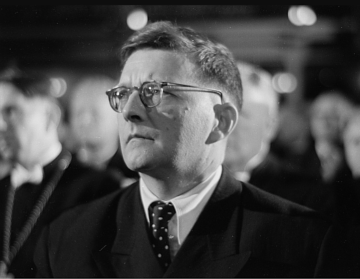Alex Ross at The New Yorker:
 Dmitri Shostakovich’s Fifth Symphony, one of the mainstays of the twentieth-century orchestral repertory, ends with an unapologetic display of musical bombast. The coda consists of thirty-five triple-forte bars in the key of D major, anchored on grandiloquent, fanfare-like gestures in the brass. The strings saw away at the note A, playing it no fewer than two hundred and fifty-two times, the winds piping along with them. The timpani pound relentlessly on D and A, the final notes accentuated by elephantine bass-drum thwacks. It is the pum-pum-pum-pum of “Also Sprach Zarathustra” run amok. The audience invariably springs to its feet.
Dmitri Shostakovich’s Fifth Symphony, one of the mainstays of the twentieth-century orchestral repertory, ends with an unapologetic display of musical bombast. The coda consists of thirty-five triple-forte bars in the key of D major, anchored on grandiloquent, fanfare-like gestures in the brass. The strings saw away at the note A, playing it no fewer than two hundred and fifty-two times, the winds piping along with them. The timpani pound relentlessly on D and A, the final notes accentuated by elephantine bass-drum thwacks. It is the pum-pum-pum-pum of “Also Sprach Zarathustra” run amok. The audience invariably springs to its feet.
If Shostakovich had written the Fifth under ordinary circumstances, the coda would present few problems. A bravura, over-the-top finish; end of story. The work arose, however, in 1937, at the time of Stalin’s Terror, and its meanings are profoundly fraught. The previous year, Stalin had conspicuously walked out of a performance of Shostakovich’s “Lady Macbeth of Mtsensk,” and the composer had been castigated in Pravda for practicing decadent formalism. While Shostakovich was at work on the Fifth, one of his highest-ranking supporters, the Soviet general Mikhail Tukhachevsky, had been executed. Not only the composer’s career but also, possibly, his life depended on what he did next.
more here.
Enjoying the content on 3QD? Help keep us going by donating now.
